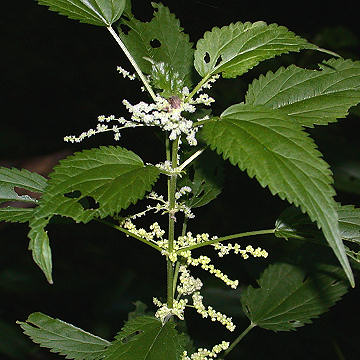

Urtica dioica - (image 1 of 5)
Taxonomy
Family: Urticaceae
Synonyms include U. procera Willd., U. gracilis Aiton, and U. dioica var. procera (Willd.) Wedd.
Habitat
Along streams on rich alluvial soil or in nitrogen rich waste ground.
Associates
Distribution
Nearly cosmopolitan.
Morphology
Rhizomatous perennial with stinging hairs, to 2 m. Leaves opposite, simple, serrate, acute or acuminate, 5-15 cm; stipules lance-linear. Dioecious; inflorescence branched, many flowered, usually surpassing the subtending petioles; male flowers with 4 subequal sepals, 4 stamens, and a vestigial ovary; female flowers with a calyx 2 mm, pubescent, the outer 2 sepals small and inconspicuous. Fruit a lenticular achene enclosed by the 2 inner sepals, ovate, 1.5 mm.
Notes
Flowers June to September
Wetland indicator: Facultative +
This species is highly variable and includes both native and introduced forms. The plants shown here are presumably the native genotype, U. dioica ssp. gracilis (Ainton) Selander, sometimes called Slender Nettle, with lanceolate to lance-ovate leaves, the uppers ones at least 2.5 times as long as wide and rounded to subcordate at the base; stems erect and with stinging hairs mostly on the lower leaf surfaces only.
Stinging Nettles are edible and can be used much like other greens. Although care should be exercised when collecting them, cooking will remove the stinging properties. The leaves are high in iron, protein, and vitamins A and C.
References
Gleason, Henry A. and A. Cronquist. 1991. Manual of Vascular Plants of Northeastern United States and Adjacent Canada. Second Ed.
The New York Botanical Garden. Bronx, NY
Peterson, L. A. 1977. A Field Guide to Edible Wild Plants: Eastern and central North America.
Houghton Mifflin Company. New York, NY
Swink, F. and G. Wilhelm. 1994. Plants of the Chicago Region.
Indiana Academy of Science. The Morton Arboretum. Lisle, Illinois.
|
Michael Hough © 2009 |